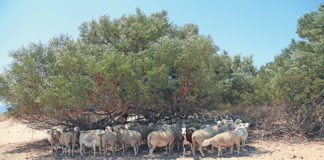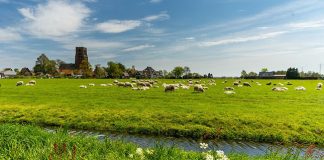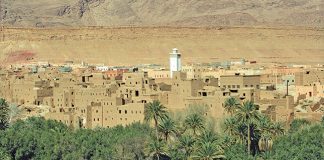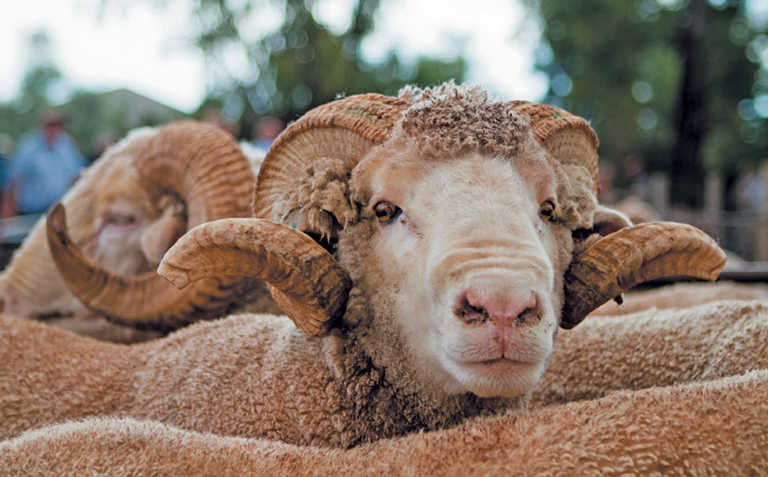
Photo: Sabrina Dean
Despite the effects of the recent widespread drought, the Southey family managed to achieve a weaning rate of 110% on their farms between Middelburg and Steynsburg in the Eastern Cape last year.
According to Hendrik van Pletzen, founder and convener of the annual Voermol Sheep Farmer of the Year competition, this was an impressive result for 2016 winner, Julian Southey, as this was attained on harsh terrain, crippled by extreme climatic conditions.
READ Amaranth farm trial: a high-potential crop for marginal land?
Recently, a large group of farmers and industry role players attended an information day on Manor Holme farm (about 6 500ha) to learn how Julian and his sons, Robert and Stuart, had achieved their success.
According to Julian, they consider the veld to be one of their most important resources, because they rely so heavily on it for production success.
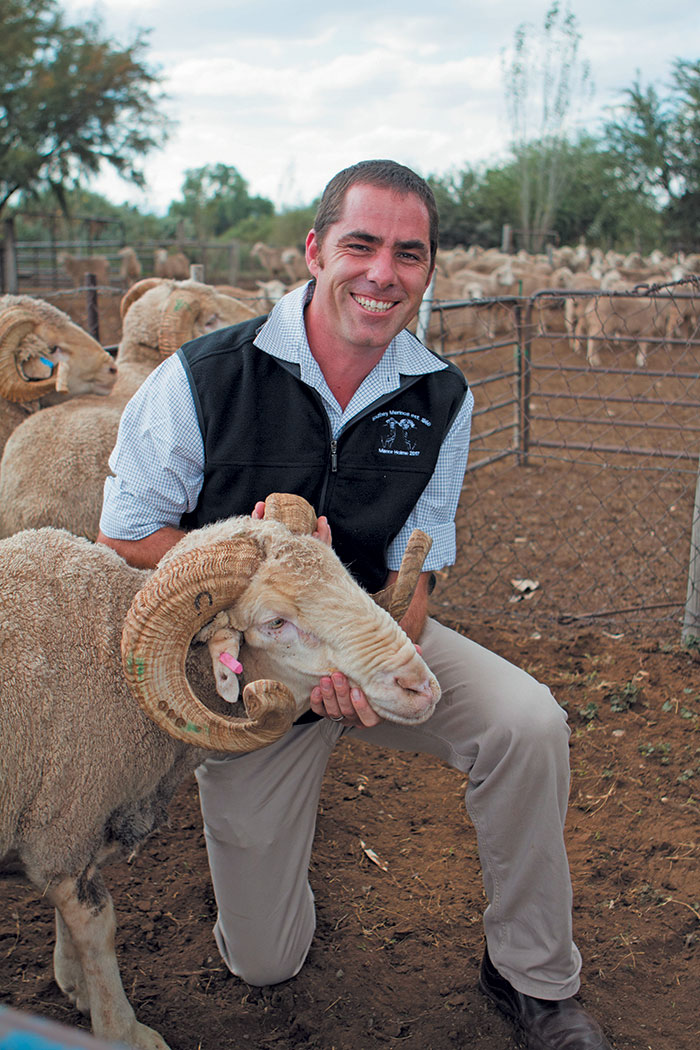
“My father used to tell me that our footprints were our most important fertiliser,” he says.
He recalls that in the 1960s and 1970s, camps were fenced and divided according to veld type, and this was largely how they had managed the veld until recently.
“All that’s changed is that we’re moving to smaller camps and grazing for shorter periods, especially after rain,” he explains.
Grazing quality
Because grazing is central to their core business of farming Merino sheep for slaughter lambs and wool production, the Southeys observe the veld and pastures closely, monitoring the quality of the grazing and preventing overgrazing.
“We do diversify a little bit, but that diversification never takes our emphasis off our core business: our bread and butter,” says Julian.
Eldest son, Robert, is passionate about the pastures on the farm and believes there is a direct correlation between the health of the soil and plants, and the health and quality of the sheep.
Robert says that when he first started farming on irrigated pasture, he began to appreciate the importance of looking after soil biology.
“Healthy soil and healthy plants produce healthy animals: healthy sheep with plenty of milk and healthy lambs that grow quickly.”
Balance and diversity
Robert stresses that they have spent a long time balancing the mineral and organic content of the soil on the farm.
They have also drawn on expert advice. For example, they have learnt much about the value of diversity from US agronomist, Neal Kinsey, and US soil health expert, Gary Zimmer.
The healthiest pasture consists of at least 20 different plant species, or even as many as 30, Robert explains.
“The more species you have, the more balanced the diet is for the animal. Different plants bring different minerals up to the surface.”
The Southeys’ permanent pasture is planted to fescue, cocksfoot, lucerne and clovers, with the oldest established in the 1980s. The planted pasture, which has a rich, dark layer of humus, is split into 2ha to 3ha camps.
Annual forage species include oats and other grains, ryegrass, grazing vetch and clover.
“We sow cover crop mixes that are used for grazing and soil conditioning between cash crops. The idea is that after we’ve harvested maize, we plant a cover crop, which is then grazed. The regrowth dissipates into the soil, and this proves very beneficial as ‘green’ manure and to condition the soil and build up microbes and good bacteria.”
Currently, the Southeys make use of centre pivot and some flood irrigation. But they are hoping to convert to even more efficient irrigation methods in time, and have just started a pilot project with an underground drip system.
“Hopefully we’ll be able to take it from there and use borehole water more sparingly,” says Robert.
Careful fodder flow planning is also important. “We have harsh winters in the Karoo, so meticulous fodder flow planning is necessary.”
Production
The Southeys currently run a flock of 4 000 ewes. The business comprises 25% stud animals and 75% commercial animals.
READ Follow these guidelines when dosing lambs
Julian says that when he first arrived on the farm Lucerndale (1 500ha) in 1987, which is where Robert is currently based, they produced 20 fleeces of 26-micron wool per bale. This figure has since stabilised “very nicely” at 19,8- to 20-micron wool with soft-handling properties, staple length and of good quality.
From the very beginning, Julian has focused on sheep fertility.
“In the old days, we weren’t happy with twins. I don’t know why, but even my dad saw it as too onerous a task. I remember my wife, Trish, bottle-feeding about 100 twins because we took one lamb away so that the mother could look after the other one. We’ve learnt so much since then.”
The Southeys also focus heavily on ewe productivity and aim to produce early-maturing lambs. In this regard, Robert emphasises the importance of keeping strict records of each lamb’s sire and dam, the age of each dam, and specific information on individual lambs. Records are also kept of every ewe mated and scanned, as well as every lamb weaned.
Old ewes, especially dry ones, are culled. “We get them off the farm so that there’s space for the production ewes,” says Julian.
All ram lambs are performance- tested. He explains that they aim to breed rams with deep bodies and good legs with long, free-flowing wool.
Rams are auctioned at the annual East Cape Merino Club Sale held in January, and again on the farm in February and September. Most lambs are sold to feedlots, but heavier ones are kept back and rounded off on the farms.
Lambs receive creep feed from a young age, and are weaned at 28kg before being sold at four to five months at about 34kg. Ram lambs are sold off as wethers, while ewe lambs are retained for replacement stock or sold as breeding stock.
Two breeding systems
Julian’s second son, Stuart, focuses primarily on livestock production, including the accelerated lambing system.
Two separate breeding systems are used. In the first, which is used for the majority of ewes in both the commercial and stud flocks, ewes are mated on a 12-month cycle (each ewe lambs once a year).
About two-thirds of ewes are mated in April/May and lamb in spring (August/September), and one-third is mated in October/November to lamb in autumn (March/April).
The second system is the accelerated lambing system in which ewes are mated every eight months, or three times in two years.
READ Twinning in cattle: benefits vs cost
“At present, we only practise the first system on the leased properties (see box), but will be looking at expanding this system to some of the other commercial flocks,” says Robert.
This is coupled with an eight-month shearing cycle, which fits in well with the lambing programme. The ewe lambs are shorn as hoggets of eight to 10 months old.
When it comes to breeding, Stuart says it is important to understand the difference between maximum and optimum. He uses the example of Merino stud animals in Western Australia, where ewes weigh well over 100kg and rams more than 180kg.
“That’s the kind of potential you can get if you feed [the animals], but you have to ask yourself whether it’s worth the amount of feed that you need to put into that animal. Obviously not.”
He says ‘optimum’ varies from one system and one farm to the other, but they aim to produce ewes weighing 55kg in the Karoo.
He also stresses the importance of calculating gross margin/ ha instead of gross margin/head. This enables him to make comparisons across farming industries.
“If you want to compare one enterprise with another, for example, cattle, maize or fruit trees, you can’t compare one cow with one ewe, or a fruit tree with a maize plant. You need to know what you’re getting per hectare because that’s what you’re working with,” he concludes.
Doubling profits
About seven years ago, the Southeys leased two parcels of land under irrigation near Teebus, close to Lucerndale, of 40ha and 50ha respectively.
Stuart calculated the farm’s overheads based on rental (including electricity and water) at R14 000/ ha/ year, and direct costs of the sheep at R12 000/ ha/ year at 20 ewes/ ha.
“What that came down to was that my break-even point on a single ewe was R1 300, or R26 000/ ha. That’s quite an amount you need to bring in before you start making any money.”
He then decided to compare the costs and profits of sheep and maize production. At that stage, maize would have outperformed sheep by a large margin. However, at present price levels, this would not have been the case, he says.
The Southeys took over a flock of 600 ewes with the 40ha farm. The average lambing rate was between 130% and 140% in a 12-month cycle. Stuart says that the animals were well-adapted and highly productive, producing about 840 lambs per year.
“That came to about R10 000 net profit/ha/year,” he says.
He then introduced the eight-month lambing cycle. Over the past four years, they have still achieved a weaning rate of 130%, but on an eight-month cycle, this equates to 195% per year.
This has enabled them to double their profit/ ha, explains Stuart.
“It was well worth it for us. Obviously, the nutrition is good here, as the animals graze on permanently irrigated pastures.”
Email Julian Southey at [email protected]









